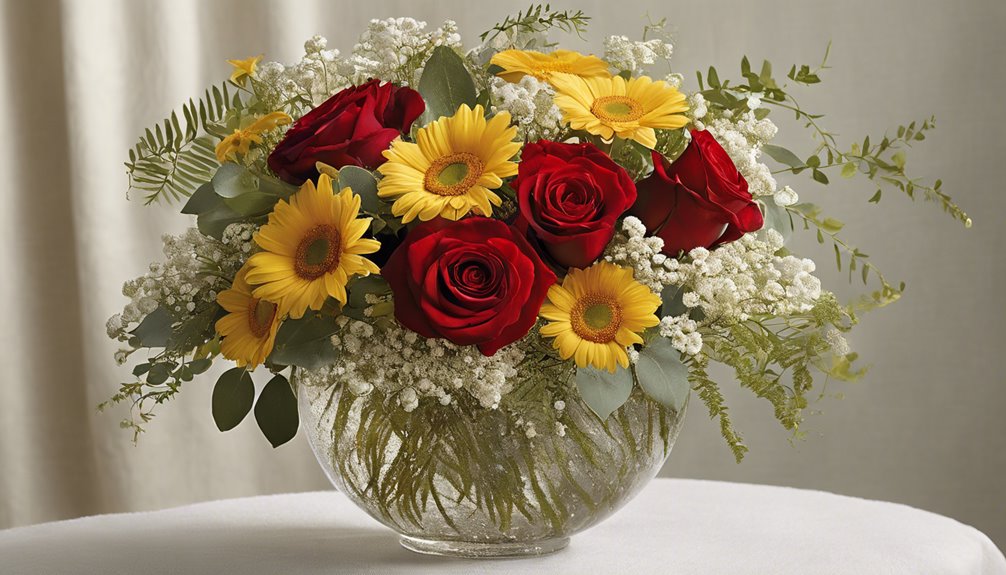As you set out on creating a stunning flower arrangement, remember that selecting the perfect blooms is vital, considering their meanings, freshness, and blooming timing. Mixing complementary flowers creates visual interest, while foliage and filler flowers add texture and depth. Understanding color harmony basics, like complementary, analogous, and triadic colors, will help you create a visually appealing arrangement. Balance colors and textures by considering monochromatic, contrasting, or harmonious palettes, and don't forget to choose a vase that sets the tone for your design. With these basics mastered, you'll be well on your way to crafting a breathtaking arrangement that's sure to impress – and there's still so much more to explore in the world of flower arrangement decoration.
Choosing the Right Flowers
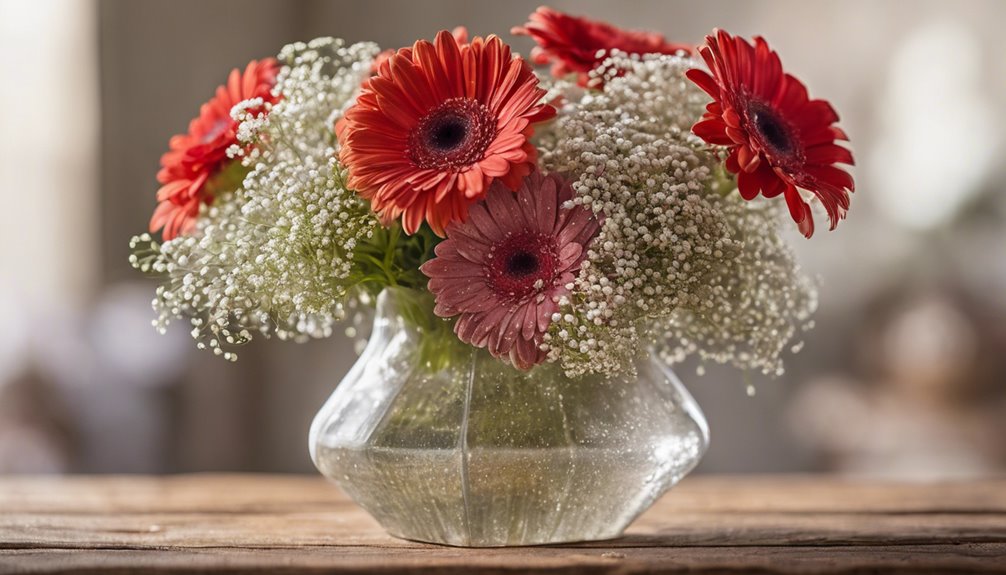
Selecting the perfect blooms is crucial to creating a stunning flower arrangement, and it all starts with understanding the different types of flowers and their unique characteristics. You'll want to ponder the flower meanings, as they can convey emotions and messages. For instance, roses symbolize love, while sunflowers represent warmth and happiness. When choosing your flowers, look for fresh cuts, as they'll last longer and stay healthier. Ponder the shapes, sizes, and colors of the blooms, as well as their textures and fragrances. Mixing complementary flowers will create visual interest and depth in your arrangement. By selecting the right flowers, you'll be well on your way to creating a beautiful, meaningful arrangement that will make anyone feel special.
Selecting Foliage and Filler Flowers
As you've curated your statement flowers, it's time to add some supporting actors to the mix. Foliage and filler flowers are essential components of a well-rounded arrangement, providing texture, depth, and visual interest. When selecting foliage, consider the various types, such as ferns, lemon leaves, and eucalyptus, each with its unique leaf shape and texture. You can choose foliage with rounded leaves, like hostas, or more angular shapes, like succulents. Filler flowers, like baby's breath or queen anne's lace, help to fill gaps and add volume to the arrangement. They can also be used to create a soft, romantic look or a more structured, geometric design. By combining statement flowers with thoughtfully chosen foliage and filler flowers, you'll create a visually stunning arrangement that tells a story.
Understanding Color Harmony Basics
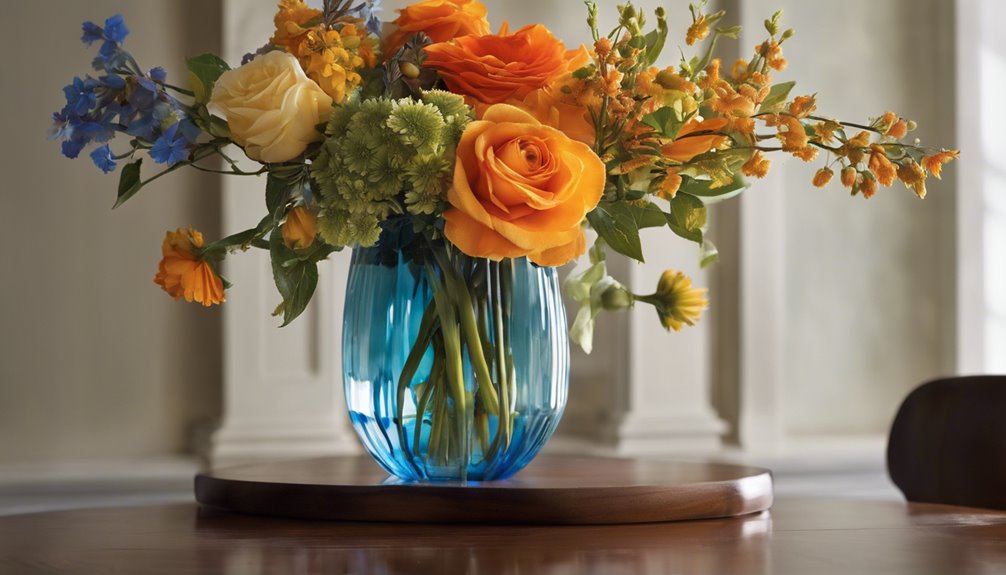
You've carefully curated your flowers, foliage, and filler flowers – now it's time to tie everything together with a harmonious color scheme. Understanding color harmony basics is key to creating a visually appealing arrangement. Start by referencing a Color Wheel to identify complementary, analogous, and triadic colors. This will help you select a cohesive Palette Option for your arrangement. Consider monochromatic, contrasting, or harmonious palettes, each evoking a unique emotional response. Monochromatic palettes feature different shades of a single color, while contrasting palettes pair bold, opposite hues. Harmonious palettes blend similar colors for a soothing effect. By applying these principles, you'll create a stunning arrangement that resonates with your personal style and captivates your audience.
Balancing Colors and Textures
As you begin to craft your arrangement, you'll want to balance colors and textures to create visual interest and harmony. You'll need to ponder harmonious hue combinations that work together seamlessly, like analogous colors or triadic palettes. By mixing rough and smooth textures, contrasting light and dark values, and balancing warm and cool tones, you'll add depth and dimension to your design.
Harmonious Hue Combinations
When creating a stunning flower arrangement, harmonious hue combinations can make all the difference. You want your colors to work together in perfect harmony, don't you? To achieve this, try color blocking, where you group flowers of similar hues together to create a cohesive look. Alternatively, opt for a monochromatic scheme, where you use different shades of the same color to add depth and interest. Remember, the key is to balance warm and cool tones, as well as brights and pastels. By doing so, you'll create a visually appealing arrangement that draws the eye and evokes emotions. With a little practice, you'll be a pro at combining colors like a seasoned florist!
Mixing Rough and Smooth
Now that you've mastered the art of harmonious hue combinations, it's time to add another layer of depth to your flower arrangements by balancing colors and textures. Mixing rough and smooth elements creates visual interest and adds complexity to your designs. Combine flowers with rough edges, like succulents or dahlias, with those featuring smooth curves, such as calla lilies or roses. This contrast will draw the eye through the arrangement, creating a sense of movement and energy. Play with different textures by incorporating various foliage, like velvety leaves or wispy ferns, to add depth and dimension. By balancing rough and smooth elements, you'll create a visually appealing arrangement that invites the viewer to explore its many layers.
Contrasting Light and Dark
You'll take your flower arrangements to the next level by balancing light and dark colors, which will add depth, dimension, and visual appeal. By combining light and dark elements, you'll create a sense of harmony and contrast that draws the eye. Dark accents, like richly colored flowers or branches, will ground your arrangement and provide a sense of stability. Meanwhile, light reflections from pale petals or glass vases will add a touch of airiness and elegance. Balancing these opposing elements will create a visually stunning arrangement that's both dynamic and cohesive.
Selecting the Perfect Vase Shape
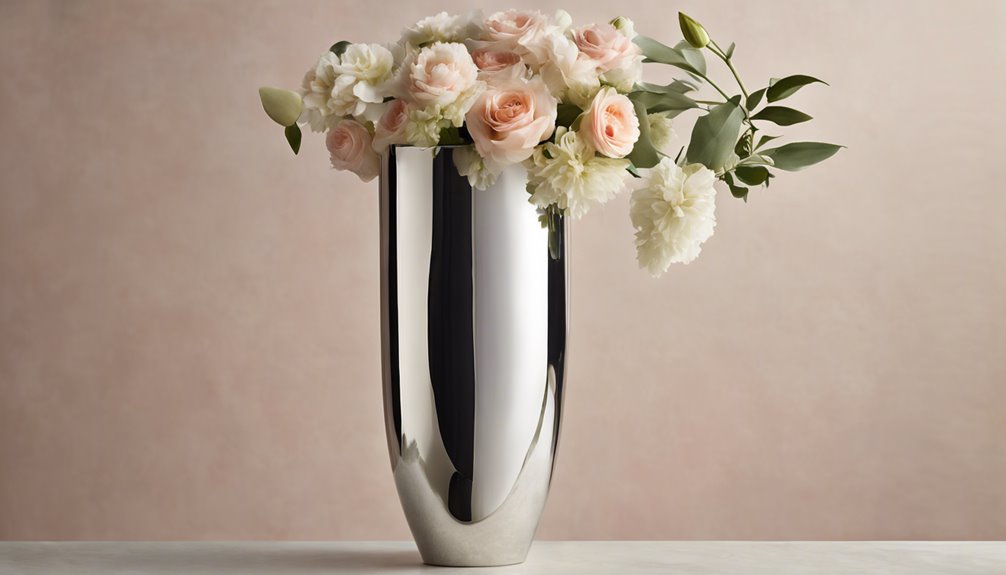
The vase shape you choose can make or break the harmony of your flower arrangement, as it sets the tone for the entire design. You're not just picking a vessel to hold your stems; you're selecting a piece that will elevate or detract from your artistic vision. With a rich vase history dating back centuries, you have a multitude of styles to draw inspiration from.
Some popular vase shapes to ponder:
- Classic Cylinder: Timeless and versatile, this shape suits most flower arrangements and styles.
- Trumpet Vase: Accentuates large, showy blooms and adds drama to your design.
- Teardrop Vase: Creates a sense of movement and flow, ideal for cascading flowers.
- Square Vase: Adds a modern, edgy touch to your arrangement, perfect for contemporary designs.
Considering Vase Size and Scale
As you choose a vase, remember that its height matters – a vase that's too short can get lost under a bouquet, while one that's too tall can overwhelm the flowers. The goal is to find a vase that's proportional to the flowers, striking a balance that creates visual harmony. By considering the scale of your arrangement, you'll certify a beautiful, cohesive look that showcases your flowers to their fullest potential.
Vase Height Matters
When selecting a vase, its height is crucial to the overall balance and harmony of your flower arrangement, and a key factor is to weigh the scale of the flowers and foliage you're working with. You want to create a visually appealing arrangement that draws the eye, not one that looks awkward or unbalanced.
Vase height considerations:
- Vase proportions: Verify the vase is in proportion to the size of your flowers and foliage. A large bouquet in a small vase can look cramped, while a small arrangement in a large vase can look lost.
- The vase height should be in harmony with the surrounding decor, taking into account the table or shelf it will sit on.
- Consider the visual impact you want to create – a tall vase can create drama, while a shorter one can create intimacy.
- Don't forget to leave some negative space to create a sense of breathability and elegance.
Proportion to Flowers
To create a harmonious flower arrangement, you'll want to balance your vase size with the scale of your flowers and foliage. This proportion is vital, as it sets the tone for the entire arrangement. Consider the scale factors of your flowers, foliage, and vase to achieve a cohesive look. A large vase demands larger flowers and foliage, while a smaller vase calls for more delicate blooms. By balancing these elements, you'll create a sense of harmony and draw focal emphasis to the arrangement's core. Remember, proportion is key to creating a stunning flower arrangement that captivates the senses.
Visual Balance Goal
With proportion in mind, you're ready to focus on achieving visual balance in your flower arrangement. Visual balance is vital, as it creates harmony and guides the viewer's eye through the arrangement. Symmetry plays a significant role in achieving visual balance, but it's not the only factor. Consider the vase size and scale to guarantee your arrangement doesn't look too crowded or too sparse.
To achieve visual balance, keep the following in mind:
- Visual flow: Create a path for the viewer's eye to follow by placing flowers and greenery in a way that leads the eye through the arrangement.
- Symmetry importance: Use symmetry to create a sense of order, but don't be afraid to break it to add visual interest.
- Vase size: Choose a vase that complements the scale of your arrangement, avoiding ones that are too large or too small.
- Negative space: Don't be afraid to leave some empty space in your arrangement to create a sense of breathability and visual balance.
Preparing Flowers for Arrangement
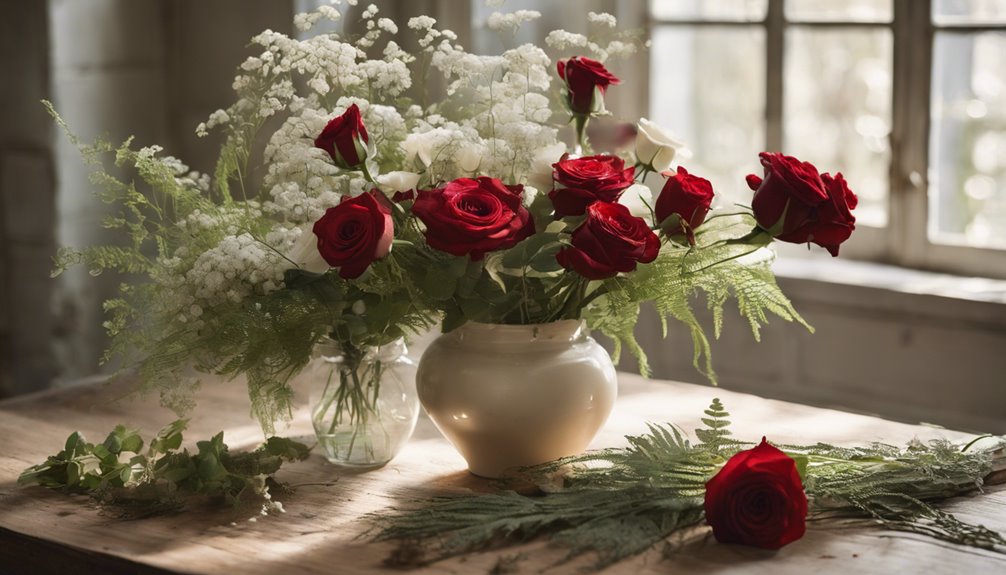
About three-quarters of the flower arrangement process involves preparing your blooms for their starring role. As you start, make sure to trim your flowers' stems at an angle, using sharp scissors or pruning shears to guarantee fresh cuts. This helps prevent the stems from sitting flat at the bottom of the vase, allowing for better water uptake. Next, check the blooming timing of your flowers. Some, like roses, take a few days to fully open, while others, like peonies, bloom rapidly. Consider the arrangement's desired lifespan and choose flowers that will bloom in harmony. Fresh stems and well-timed blooms are essential for a stunning arrangement that will impress anyone.
Creating a Focal Point Design
As you begin creating a focal point design, you'll want to select a main flower that draws the eye and sets the tone for your arrangement. This focal flower should be striking, whether due to its color, shape, or size, and will serve as the anchor for your design. By balancing this central element with complementary blooms and foliage, you'll create a visually appealing arrangement that guides the viewer's gaze.
Main Flower Selection
When crafting a focal point design, you'll want to choose a main flower that demands attention and sets the tone for your arrangement. This flower will be the star of the show, so select one that showcases fresh blooms in a vibrant petal palette. Consider the following options:
- Peonies: Lush and full, peonies add a touch of elegance to any arrangement.
- Sunflowers: Bright and cheerful, sunflowers are sure to draw the eye.
- Roses: Timeless and romantic, roses come in a variety of colors to suit your design.
- Orchids: Exotic and sophisticated, orchids add a level of refinement to your arrangement.
Visual Balance Creation
Now that you've chosen your main flower, it's time to create a visually balanced arrangement that draws the eye to your focal point. Visual balance is achieved through the principles of symmetry and asymmetry. Symmetry principles involve creating a mirrored effect on either side of the arrangement, while asymmetry rules rely on balancing visual weight through contrasting elements. To create a focal point design, consider the size, shape, and color of your main flower. Place it off-center to create visual tension, then balance it with complementary flowers, foliage, and decorative elements. Remember, the goal is to guide the viewer's eye to your main flower, so use contrasting textures, colors, and shapes to create visual harmony.
Working With Different Flower Shapes
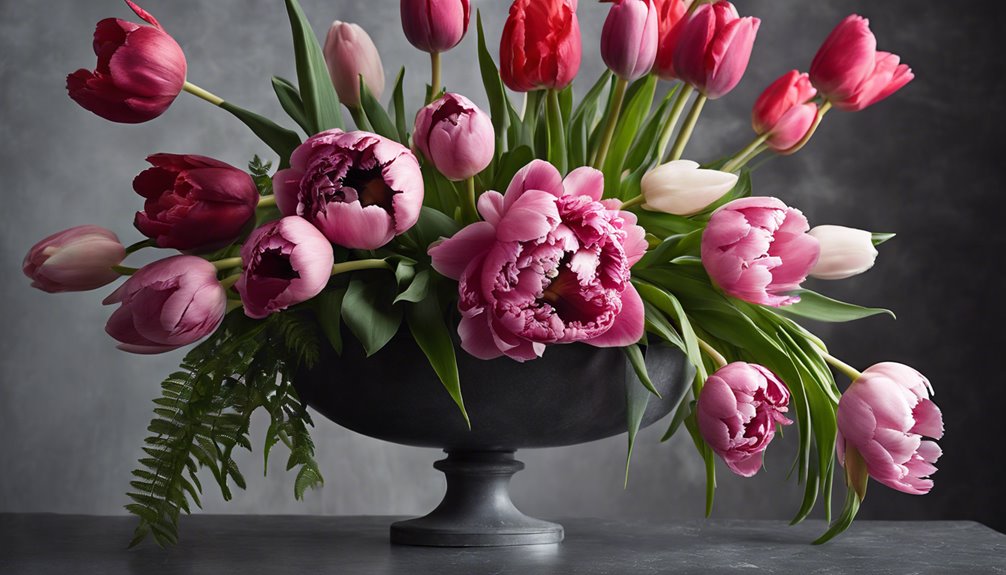
Your flower arrangement's visual appeal largely depends on the shapes and forms of the flowers you're working with. As you select flowers, consider their unique characteristics, such as petal patterns and shapes, to create a visually stunning arrangement.
Here are some flower forms to work with:
- Round flowers, like peonies and roses, add softness and romance to your arrangement.
- Linear flowers, like calla lilies and glads, create a sense of height and drama.
- Bell-shaped flowers, like tulips and daffodils, add a touch of whimsy and playfulness.
- Orchid-shaped flowers, like cymbidiums and phalaenopsis, bring an exotic and sophisticated feel to your arrangement.
Adding Finishing Touches and Embellishments
A beautiful flower arrangement is more than just a collection of blooms; it's a carefully crafted composition that requires a few finishing touches to elevate it from lovely to stunning. You've chosen your flowers, foliage, and vase, but now it's time to add the extras that make your arrangement truly special.
| Finishing Touch | Description |
|---|---|
| Floral Accents | Add delicate, intricate details with floral accents like tiny flowers, leaves, or berries. |
| Decorative Picks | Use decorative picks to add texture, color, and visual interest to your arrangement. |
| Filler Flowers | Incorporate filler flowers like baby's breath or queen anne's lace to add volume and depth. |
Frequently Asked Questions
Can I Use Artificial Flowers in a Professional Arrangement?
You can absolutely use artificial flowers in a pro arrangement, considering them a flower substitute that offers a floral compromise between fresh blooms and long-lasting beauty, allowing you to create stunning designs that won't wilt under pressure.
How Do I Prevent Flowers From Drooping in the Vase?
To keep your stems standing tall, you'll want to trim them at an angle, removing any leaves below the waterline, and condition your flowers by soaking them in warm water with floral preservative to rehydrate and strengthen them.
What Is the Best Way to Clean My Flower Vase?
Your vase is a canvas, waiting for a fresh stroke of cleanliness. Gently scrub your glass or ceramic vase with mild dish soap and warm water, then rinse thoroughly to remove any residue, leaving it sparkling like new.
How Often Should I Change the Water in the Vase?
You'll want to change the water in your vase every 2-3 days to guarantee superior water quality, especially for fresh cut flowers, which need a clean environment to thrive and stay hydrated.
Can I Reuse Flowers From a Previous Arrangement?
You're a flower whisperer, reviving beauty from wilted petals! While it's tempting to reuse flowers from a previous arrangement, it's generally not recommended. Fresh blooms shine brighter, and flower recycling can be a recipe for bacterial growth and pest infestations.

